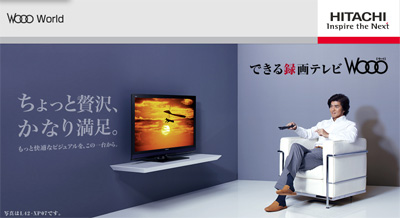JAPAN: Hitachi latest to pull out of TV manufacturing as new technologies fail to Wooo customers
Company follows Japanese industry trend of outsourcing production overseas, after 55 years of in-house manufacture


Slow demand, intense price competition and wafer-thin profit margins are behind Hitachi's decision to stop TV manufacturing in Japan, and outsource production to overseas contract manufacturing.
And it's thought the company's decision, taken after 55 years of in-house TV production, could open the door for other Japanese manufacturers to follow the same route, faced as they are with losses in their TV divisions.
Hitachi plans to be out of TV manufacturing by March next year, with the closure of its plant in Minokamo, in Japan's Gifu Prefecture and the shift overseas of production of Hitachi-branded sets.

It's thought the decision has been a tough one for the company, since TVs have been a central part of its business since it started making them in 1956, just three years after TV transmissions started in Japan.
The first set was the F-100, a 14in black and white model, and in 1960 the company sold its first colour TV: it sold for Y520,000, which would be £4000 at today's exchange rates.
And therein lies the problem for Japanese TV manufacturers: price-slashing by retailers worldwide has seen manufacturer profit margins shaved wafer-thin, and according to market analysts worse – at least for manufacturers – is yet to come.
US market research company Display Search says that by the last quarter of 2015, the average price of an LCD TV in the States will be around £200, down 40% from 2009 levels.
Get the What Hi-Fi? Newsletter
The latest hi-fi, home cinema and tech news, reviews, buying advice and deals, direct to your inbox.

Hitachi has tried a variety of strategies to attract consumers to its TV, but despite the 'Wooo' name under which they're sold in Japan, its products have failed to excite consumers enough to return improved profitability.
It's a problem afflicting the whole Japanese TV industry: while 3D was much-heralded as a means for companies to stave off price-erosion and sell some premium-priced TVs, it's so far failed to deliver, and features such as internet connectivity are also failing to do the business, simply because consumers have so many other ways of accessing internet content.
As one Japanese industry executive told the Nikkei business news, 'high-performance TVs that have been launched recently, including 3-D TVs, have all proved duds, and no maker has found a successful formula for next-generation television yet.'
In the modern TV market, even premium features become commoditised in very short order, and prices start tumbling. Good for consumers after a bargain; bad for manufacturers hoping to turn a profit.
Sony is reported to be planning rapid action to tackle its loss-making TV division, and Panasonic president Fumio Ohtsubo has announced the company will be making no new investments in its TV business, and that it's working on a plan to re-invent its TV operations.
Neither company is ruling out a complete shift of production from Japan to lower-cost countries, where more than 50% of Sony and Toshiba sets are already made
Slipping demand, a strong Yen, and intense price-competition: looks like a serious shake-out of the Japanese TV manufacturing business is inevitable.
Andrew has written about audio and video products for the past 20+ years, and been a consumer journalist for more than 30 years, starting his career on camera magazines. Andrew has contributed to titles including What Hi-Fi?, Gramophone, Jazzwise and Hi-Fi Critic, Hi-Fi News & Record Review and Hi-Fi Choice. I’ve also written for a number of non-specialist and overseas magazines.
